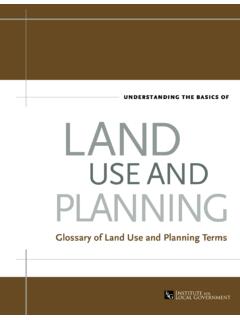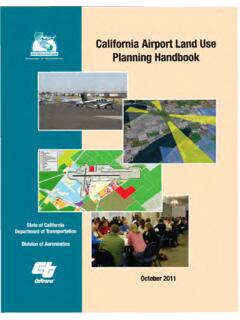Transcription of FLORIDA LAND USE, COVER AND FORMS CLASSIFICATION …
1 FLORIDA land USE, COVER AND FORMS CLASSIFICATION SYSTEM HANDBOOK JANUARY 1999 DEPARTMENT OF transportation SURVEYING AND MAPPING GEOGRAPHIC MAPPING SECTION FLORIDA land USE, COVER AND FORMS CLASSIFICATION SYSTEM FLORIDA DEPARTMENT OF transportation SURVEYING AND MAPPING OFFICE GEOGRPAHIC MAPPING SECTION HANDBOOK JANUARY 1999 Third Edition Responsible Office: Surveying & Mapping Office FLORIDA land USE, COVER AND FORMS CLASSIFICATION SYSTEM ABOUT THIS EDITION: This is an updated FLORIDA land USE, COVER AND FORMS CLASSIFICATION SYSTEM. The September 1985 version is almost intact as it was except for a few added classifications. We would like to thank the FLORIDA Department of Environmental Protection for their input in adding some "Wetland Classes." We left most all the Introduction as it was in the Second Edition.
2 PURPOSE: In the years since the original edition of the land USE, COVER AND FORMS CLASSIFICATION SYSTEM was initiated, the Geographic Mapping Section has evolved simultaneously with the expanding technologies of remote sensing and digital mapping systems. The section now routinely employs more sophisticated, state-of-the-art FORMS of aerial photography, Landsat MultiSpectral Scanner (MSS) data and Landsat Thematic Mapper (TM) data. Additionally, most image data reduced from remotely sensed images and all non-image data is stored in a computer-supported geographic information system. The increased use of these resources has led to very precise CLASSIFICATION of land use, COVER and FORMS and a flexible means of capturing not only image data but also auxiliary non-image data in a comprehensive land use/ COVER / FORMS data base. As a result of these increased capabilities, the mission of the Thematic Mapping Section has expanded greatly, necessitating a new edition of the FLORIDA land USE, COVER AND FORM CLASSIFICATION SYSTEM.
3 In 1971, the Geographic Mapping Section was established within the Topographic Bureau, now the Surveying and Mapping Office, of the FLORIDA Department of transportation . Our mission then, as it is now, was to assist upon request other state agencies in their mapping activities. Although our primary responsibility is to the Department of transportation , the section will intermittently serve the needs of other Governmental Agencies. 1 2A committee representing eight state agencies was formed in 1973 to improve land resources data coordination within the various state agencies by reducing duplication of effort and increasing the value of data for serving multiple purposes. The committee's objective was to establish a uniform land CLASSIFICATION system that would satisfy a wide variety of users. It was determined that the system must be compatible with CLASSIFICATION activities at the national level while permitting flexibility for regional and local agencies.
4 After a general evaluation of the current CLASSIFICATION systems then in use, it was agreed that the United States Geological Survey report, "A land -Use CLASSIFICATION System for Use With Remote-Sensor Data," commonly known as Circular 671, would be the basis for the committee's work. A system was designed primarily to meet needs of state agencies, local governments and private enterprise, and to allow user flexibility in modifying the classifications to meet individual needs without seriously impairing the exchange of data. The result of the committee's work was the publication of the FLORIDA land USE AND COVER CLASSIFICATION SYSTEM in 1976. This publication encompassed complete sub-categorization of Levels I and II of the CLASSIFICATION system, but left the sub-categorization of Level III to the discretion of individual organizations. However, after the publication of the original CLASSIFICATION system, requests for specific identification became more demanding, especially in land COVER .
5 In response, land use and vegetation categories were adopted from suggestions furnished primarily by environmentalists, reflecting various users' needs and interests, and incorporated into Levels III and IV. Therefore, in subsequent revisions of the system categorization, Level III was revised to meet the needs of the Department of transportation and other state agencies requesting Department land use and land COVER maps. The resulting CLASSIFICATION scheme was not a fixed system but remained a system which was flexible to specific user requirements. (An in-depth discussion of the level structure and guidelines for sub-categorization may be found in the Geological Survey paper, authored by James R. Anderson et al in 1976, entitled: "A land -Use/ land COVER CLASSIFICATION System for Use with Remote Sensing Data," Professional Paper 964). Accompanying this report is a section on mapping physiographic features previously not associated with land use inventory.
6 Soil, drainage and geological features affect land use in many respects and, therefore, must be considered by planners in making 3decisions regarding land use in an area. This new edition of the CLASSIFICATION system includes in-depth definitions of classes falling in Levels I, II and, where needed, III. Also included is a complete hierarchical listing of all classes in Levels I through IV. Users familiar with the past edition will note that Levels III and IV have been greatly expanded. In many instances the text was reformatted and expanded in order to appeal to a wider audience and new sections were added relating the objectives and capabilities of the Geographic Mapping Section to potential users of our products and services. While this CLASSIFICATION scheme is a direct result of requests from data users and expanded capabilities, the elements of the scheme do not represent every user need since there are limitations in every system.
7 Yet, the structure of the system remains flexible enough to meet new CLASSIFICATION requirements as they arise. It is felt that this type of information has proven useful and will continue to be an effective part of the inventory system. This manual was written to serve as a companion document to land use maps compiled by the FLORIDA Department of transportation Geographic Mapping Section of the State Surveying and Mapping Office. Its primary purpose is to clarify, in some detail, the land use/ COVER / FORMS annotations assigned to the various polygons which make up a land use map. It is hoped that through reading and understanding this manual the users of the products and services provided by the Geographic Mapping Section will come to understand and appreciate the logic, techniques and philosophies employed by image analysts during map compilation. However, by no means was it intended that this manual serve as a guide to image interpretation.
8 Such an objective is beyond the scope of this publication. We would like the reader to be aware that many texts of this nature have been published which COVER not only a broad variety of land uses and COVER types but also many which address specialized uses and resources (see Appendix F). Additionally, it is hoped that this effort will serve as a model for other state agencies to follow in their activities in land use mapping. When this practice is adopted, exchange and adaptation of land use data will be greatly facilitated, particularly when handled in a form compatible with computer- based geographic information systems. Third Edition, January, 1999 4 AUTHORITY: 5 TABLE OF CONTENTS PURPOSE .. 1 AUTHORITY .. 4 TABLE OF CONTENTS .. 5 PROCEDURE SECTION I THE GEOGRAPHIC MAPPING SECTION .. 7 GENERAL DESCRIPTION OF THE FLORIDA land USE, COVER AND FORMS CLASSIFICATION SYSTEM.
9 8 SCOPE AND USE OF THE SYSTEM .. 9 CLASS DEFINITIONS 100 URBAN AND BUILT-UP .. 12 200 AGRICULTURE .. 22 300 RANGELAND .. 27 400 UPLAND FOREST .. 29 500 WATER .. 37 600 WETLANDS .. 40 700 BARREN land .. 49 800 transportation , COMMUNICATION AND UTILITIES .. 51 900 SPECIAL CLASSIFICATIONS .. 54 SECTION II DESCRIPTIONS AND DEFINITIONS OF GEOLOGIC FEATURES .. 54 DESCRIPTIONS AND DEFINITIONS OF SOILS 56 DESCRIPTIONS AND DEFINITIONS OF DRAINAGE FEATURES MAPPING .. 58 6 APPENDICES A land USE AND COVER CLASSIFICATIONS LISTING OF LEVELS I - IV .. 61 B EXAMPLES OF land USE AND VEGETATION INVENTORY 79 C EXAMPLES OF GEOLOGICAL FEATURES, SOILS AND DRAINAGE MAPS .. 82 D COMMON AND SCIENTIFIC NAMES OF MAJOR PLANT 85 E ENGLISH TO METRIC SYSTEM CONVERSIONS .. 89 F BIBLIOGRAPHY AND REFERENCES .. 90 7 PROCEDURE: (1) THE GEOGRAPHIC MAPPING SECTION Before expanding upon the land Use, COVER and FORMS CLASSIFICATION System, it may prove beneficial to the reader if the purpose and objective of the Geographic Mapping Section of FLORIDA 's Department of transportation Surveying and Mapping Office are briefly described.
10 The section is divided into three subsections: Photo Interpretation, FLORIDA Landsat Data Analysis System and County Mapping. The primary task of the Photo Interpretation subsection is to reduce the large volume of data captured by aerial photographs into a meaningful, easily understood format. This is accomplished by delineating homogeneous polygons on the imagery which correspond with identifiable land features, covers and uses. The majority of interpretation is facilitated by medium-scale (1:25,000) panchromatic black and white aerial photography. However, the Geographic Mapping Section has received an increasing number of project requests which require the use of either natural color or false color infrared, large-scale imagery for special purpose studies. The type and scale of imagery employed are dependent upon the level of interpretation being executed. The FLORIDA Landsat Data Analysis System subsection processes both Multispectral Scanner (MSS) and Thematic Mapper (TM) satellite images gathered by the Landsat program.







